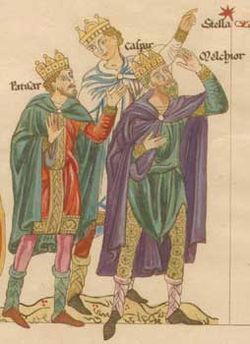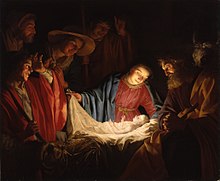
John the Apostle, also known as Saint John the Beloved and, in Eastern Orthodox Christianity, Saint John the Theologian, was one of the Twelve Apostles of Jesus according to the New Testament. Generally listed as the youngest apostle, he was the son of Zebedee and Salome. His brother James was another of the Twelve Apostles. The Church Fathers identify him as John the Evangelist, John of Patmos, John the Elder, and the Beloved Disciple, and testify that he outlived the remaining apostles and was the only one to die of natural causes, although modern scholars are divided on the veracity of these claims.

The Shrine of the Three Kings, Tomb of the Three Kings, or Tomb of the Three Magi is a reliquary traditionally believed to contain the bones of the Biblical Magi, also known as the Three Kings or the Three Wise Men. This shrine is a large gilded and decorated triple sarcophagus situated above and behind the high altar of Cologne Cathedral in western Germany. Built approximately from 1180 to 1225, it is considered the high point of Mosan art by various historians and scholars, and ranks amongst the largest reliquary in the Western world.
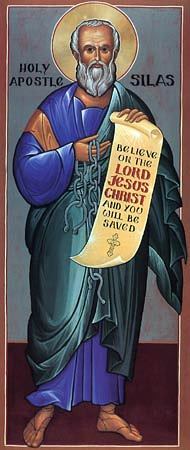
Silas or Silvanus was a leading member of the Early Christian community, who according to the New Testament accompanied Paul the Apostle on his second missionary journey.
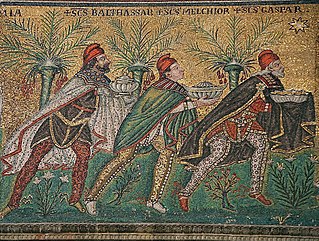
In Christianity, the Biblical Magi, also known as the Three Wise Men, Three Kings, and Three Magi, are distinguished foreigners who visit Jesus after his birth, bearing gifts of gold, frankincense, and myrrh in homage to his birth. As such, the Magi are commemorated on the feast day of Epiphany—sometimes called "Three Kings Day"—and commonly appear in the nativity celebrations of Christmas.

The Adoration of the Magi or Adoration of the Kings or Visitation of the Wise Men is the name traditionally given to the subject in the Nativity of Jesus in art in which the three Magi, represented as kings, especially in the West, having found Jesus by following a star, lay before him gifts of gold, frankincense, and myrrh, and worship him. It is related in the Bible by Matthew 2:11: "On entering the house, they saw the child with Mary his mother; and they knelt down and paid him homage. Then, opening their treasure chests, they offered him gifts of gold, frankincense, and myrrh. And having been warned in a dream not to return to Herod, they left for their own country by another path".

Epiphany, or Eid al-Ghitas, also known as "Theophany" in Eastern Christian tradition, is a Christian feast day commemorating the visit of the Magi, the baptism of Jesus, and the wedding at Cana.

"We Three Kings", original title "Three Kings of Orient", also known as "We Three Kings of Orient Are" or "The Quest of the Magi", is a Christmas carol that was written by John Henry Hopkins Jr. in 1857. At the time of composing the carol, Hopkins served as the rector of Christ Episcopal Church in Williamsport, Pennsylvania, and he wrote the carol for a Christmas pageant in New York City. It was the first widely popular Christmas carol written in America.

Chalking the door is a Christian Epiphanytide tradition used to bless one's home, which originated in medieval Europe.
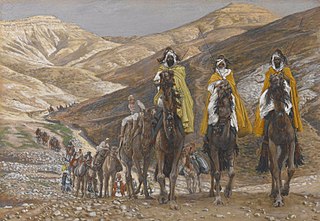
Matthew 2:1 is the first verse of the second chapter of the Gospel of Matthew in the New Testament. The previous verse ends with Jesus being named by his father. This verse marks the clear start of a new narrative, although the use of a quotation from Isaiah 7:14 in Matthew 1:23 is also reflected in the use of four Old Testament quotations in chapter 2 and the Greek: δέ in the opening words of this verse creates a continuative effect, leading directly on from the birth of the child to another connected history.

Matthew 2:11 is the eleventh verse of the second chapter of the Gospel of Matthew in the New Testament. The magi, dispatched by King Herod, have found the small child Jesus and in this verse present him with gifts in an event known as the Visit of the Wise Men. In art, is traditionally referred to as the Adoration of the Magi.

The Cavalcade of Magi is a traditional parade with floats carrying the wise men taking place in practically all Spanish cities and villages, in Andorra and Argentina, in some cities and towns in Mexico and Gibraltar. The Magi ride through the streets, as their pages collect children's letters to the kings and also throw candy to children. The cavalcade usually includes dancers, musicians, and pages, as well as other assistants to the kings.
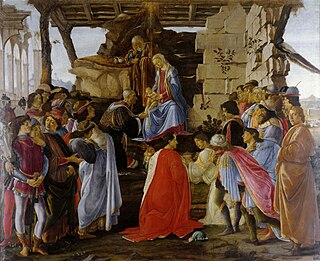
The Adoration of the Magi is a painting by the Italian Renaissance master Sandro Botticelli. Botticelli painted this piece for the altar in Gaspare di Zanobi del Lama's chapel in Santa Maria Novella around 1475. This painting depicts the Biblical story of the Three Magi following a star to find the newborn Jesus. The image of the altarpiece centers on the Virgin Mary and the newborn Jesus, with Saint Joseph behind them. Before them are the three kings who are described in the New Testament story of the Adoration of the Magi. The three kings worship the Christ Child and present him with gifts of gold, frankincense and myrrh. In addition, the Holy Family is surrounded by a group of people who came to see the child who was said to be the son of God.

The Nativity of Jesus has been a major subject of Christian art since the 4th century.
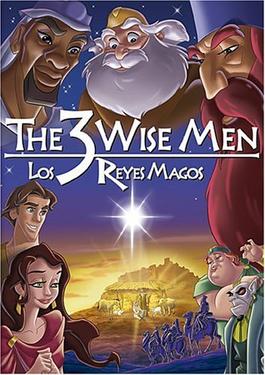
Los Reyes Magos is a 2003 Spanish animated film. It tells the story of the visit of the Magi to the baby Jesus and the wrath of Herod. The film was directed by Antonio Navarro, who was nominated for a Goya Award for this film. The film contains the voice talents of José Coronado, Juan Echanove and Imanol Arias in the original version and the voice acting of father-son actors Martin Sheen and Emilio Estevez in the English dub.

Star singers, also known as Epiphany singers, or Star boys' singing procession (England), are children and young people walking from house to house with a star on a rod and often wearing crowns and dressed in clothes to resemble the Three Magi. The singing processions have their roots in an old medieval ecclesiastical play, centred on the Biblical Magi of the Christmas story in the Gospel of Matthew, appropriate to Epiphany. It is observed usually during the period between 27 December and 6 January.

The Adoration of the Kings is an oil-on-panel painting of the Adoration of the Magi by the Netherlandish Renaissance artist Pieter Bruegel the Elder, painted in 1564, and now in the National Gallery, London.

Caspar was one of the 'Three Kings', along with Melchior and Balthazar, representing the wise men or Biblical Magi mentioned in the Bible in the Gospel of Matthew, verses 2:1-9. Although the Bible does not specify who or what the Magi were, since the seventh century, the Magi have been identified in Western Christianity as Caspar, Melchior and Balthasar. Caspar and the other two Magi are considered saints by the Catholic Church.

Balthazar, also called Balthasar, Balthassar, and Bithisarea, was according to Western Christian tradition one of the three biblical Magi along with Caspar and Melchior who visited the infant Jesus after he was born. Balthazar is traditionally referred to as the King of Arabia and gave the gift of myrrh to Jesus. In the Catholic Church, he is regarded as a saint.

Adoration of the Magi is an oil on panel painting from the early 1520s by the Dutch Renaissance artist Jan Mostaert in the collection of the Rijksmuseum, Amsterdam, where in 2020 it was on display in room 0.1. The panel measures 51 cm × 36.5 cm, and the painted surface a little less at 48.5 cm × 34 cm. It is often called the Mostaert Amsterdam Adoration in art history, to distinguish it from the multitude of other paintings of the Adoration of the Magi.
